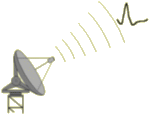|

Parameter Estimation of Human Nerve C-Fibers using
Matched Filtering and Multiple Hypothesis Tracking
Björn Hammarberg (Hansson),
Clemens Forster,
and
Erik Torebjörk
Accepted for publication in IEEE Transactions on Biomedical Engineering.
Longer version: Report, Signals and Systems Group, Uppsala University.
-
Abstract:
- We describe how multiple target tracking may be used
to estimate conduction velocity changes and recovery constants of
human nerve C-fibers. These parameters discriminate different types
of C-fibers and persuing this may promote new insights into
differential properties of nerve fiber membranes.
Action potentials (APs) were recorded from C-fibers in the peroneal
nerve of awake human subjects. The APs were detected by a matched
filter constituting a maximum likelihood constant false alarm rate
detector.
Using the multiple hypothesis tracking method and Kalman filtering,
the detected APs (targets) in each trace (scan) were associated to
individual nerve fibers (tracks) by their typical conduction
latencies in response to electrical stimulation. The measurements
were one-dimensional (range only) and the APs were spaced in time
with intersecting trajectories. In general, the AP amplitude of each
C-fiber differed for different fibers. Amplitude estimation was
therefore incorporated into the tracking algorithm to improve the
performance.
The target trajectory was modeled as an exponential decay with three
unknowns. These parameters were estimated iteratively by applying
the simplex method on the parameters that enter nonlinearly and the
least squares method on the parameters that enter linearly.
-
Related publications:
-
Paper version in IEEE Trans. Biomedical
Engineering, vol 49, April 2002.
SPIE Conference paper on the detection and tracking.
Master thesis on the implementation of the tracking problem.
-
Source:
-
|
Related research
|
Main
entry in list of publications
|
Personal use of this material is permitted.
However, permission to reprint/republish this material for
advertising or promotional purposes or for creating new
collective works for resale or redistribution to servers or lists,
or to reuse any copyrighted component of this work in other works
must be obtained from the IEEE.
|




